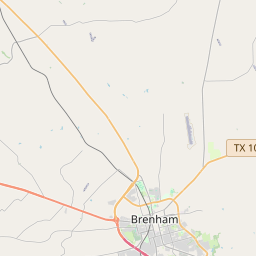Allcorn-Kokemoor Farmstead
Historical marker location:






ELIJAH ALLCORN IMMIGRATED TO TEXAS IN LATE 1821 WITH HIS WIFE, NANCY (HODGE), AND THEIR SIX CHILDREN AS “OLD 300” SETTLERS IN STEPHEN F. AUSTIN’S COLONY. ON JAN. 1, 1822, A GROUP INCLUDING ALLCORN CAMPED ALONG A BRAZOS RIVER TRIBUTARY WHICH THEY NAMED NEW YEAR CREEK. ALLCORN WAS GRANTED LAND IN CURRENT WASHINGTON, WALLER AND FORT BEND COUNTIES, INCLUDING A PARCEL ALONG NEW YEAR CREEK. HE WAS A FARMER, STOCKRAISER AND FREIGHT HAULER, BRINGING GOODS TO SETTLERS FROM THE FERRY ESTABLISHED AT WASHINGTON-ON-THE-BRAZOS IN 1835. HE ALSO SIGNED THE PETITION REQUESTING ESTABLISHMENT OF THE WASHINGTON MUNICIPALITY. ELIJAH AND NANCY DIED NINE DAYS APART IN 1844. THEIR SON THOMAS JEFFERSON ALLCORN, HIS WIFE AMEY (CAPLE) AND THEIR CHILDREN LIVED HERE FROM THE 1840s to 1870s.
ARCHEOLOGICAL INVESTIGATION OF ARTIFACTS AND TIMBERS DATES THE OLDEST SECTION OF THE MAIN HOUSE, A TWO-STORY I-PLAN OF BRACE-FRAME CONSTRUCTION, TO c. 1845. A TWO-STORY WING WAS ADDED IN 1877, BY THE WILKINS OR SAMUEL FAMILIES. IN SEP. 1887, OSCAR SAMUEL SOLD THE HOUSE TO HENRY KOKEMOOR FOR $6,100. HENRY MARRIED FRIEDA HOLLE IN 1887 AND BOUGHT THE PROPERTY WITH FINANCIAL HELP FROM HIS FATHER-IN-LAW. THE KOKEMOORS MADE SEVERAL ADDITIONS, INCLUDING A KITCHEN WING AND A MOTHER-IN-LAW ROOM IN THE 1890s. A FINAL ADDITION WAS MADE IN THE 1950s. THE PROPERTY REMAINED IN THE KOKEMOOR FAMILY FOR MORE THAN A CENTURY. EXTERIOR HOUSE FEATURES INCLUDE PROJECTING WINGS, AN L-SHAPED PORCH, METAL-CLAD GABLED ROOFS, WOOD SIDING, AND A VARIETY OF DOORS AND WINDOWS. SIMPLE FINISHES, SUCH AS PAINTED TONGUE AND GROOVE CEDAR AND LONGLEAF PINE WALL AND CEILING BOARDS, DISTINGUISH THE INTERIORS. HISTORIC OUTBUILDINGS AND STRUCTURES, BUILT BETWEEN 1890 AND 1930, INCLUDE A ROCK AND BRICK CISTERN, A BARN, GARAGE, TWO WELLS AND TWO SHEDS. THE HOMESTEAD REPRESENTS EVOLUTION FROM A FORMAL FLOOR PLAN TYPICAL OF THE MID-19TH CENTURY TO A COMPOUND PLAN AND CONTINUING AGRICULTURAL USE INTO THE 20TH CENTURY
As one of the most visible programs of the Texas Historical Commission (THC), historical markers commemorate diverse topics in Texas history, including: the history and architecture of houses, commercial and public buildings, religious congregations, and military sites; events that changed the course of local and state history; and individuals who have made lasting contributions to the state, community organizations, and businesses.
More history nearby
The cattle industry played a significant role in the development of Texas, with cowboys driving cattle from Texas to railheads in Kansas during the late 1800s and early 1900s.
In its early years, Washington County was primarily an agricultural community, with cotton being the main crop. Many German immigrants settled in the area and brought with them their farming expertise and traditions. These settlers played a crucial role in shaping the county's agricultural landscape and introducing a strong cultural influence that is still evident today.
During the Civil War, Washington County saw its fair share of conflict and upheaval. The county was divided in its loyalties, with some residents supporting the Confederacy while others opposed secession. The region experienced military occupation and witnessed battles and skirmishes, leaving a lasting impact on its residents.
In the late 19th and early 20th centuries, Washington County transitioned from an agrarian economy to a more diversified one. With the arrival of the railroad, the county experienced a boost in commerce and industry. Businesses and services expanded, and the county's population grew as a result. Today, Washington County is known for its thriving agricultural industry, historical sites, and picturesque landscapes, attracting visitors from around the country.
Overall, Washington County, Texas has a storied past that reflects the broader history of the state. From its early origins as an agricultural community to its role in the Civil War and subsequent development, the county has played a significant part in shaping the growth and identity of Texas.
Washington County Timeline
This timeline provides a concise overview of the key events in the history of Washington County, Texas.
- 1834 - Washington County is organized as the first county in the Republic of Texas
- 1836 - The Battle of San Jacinto takes place, securing Texas independence
- 1838 - Washington-on-the-Brazos becomes the first capital of the Republic of Texas
- 1851 - Brenham is established as the county seat
- 1861 - Texas secedes from the Union and joins the Confederate States of America
- 1870 - The Houston and Texas Central Railroad reaches Brenham, boosting the local economy
- 1930s - The Great Depression impacts the agricultural industry in Washington County
- 1950 - Blue Bell Creameries is founded in Brenham
- 1972 - Washington-on-the-Brazos State Historic Site is established
- 1990s - Washington County experiences population growth and development